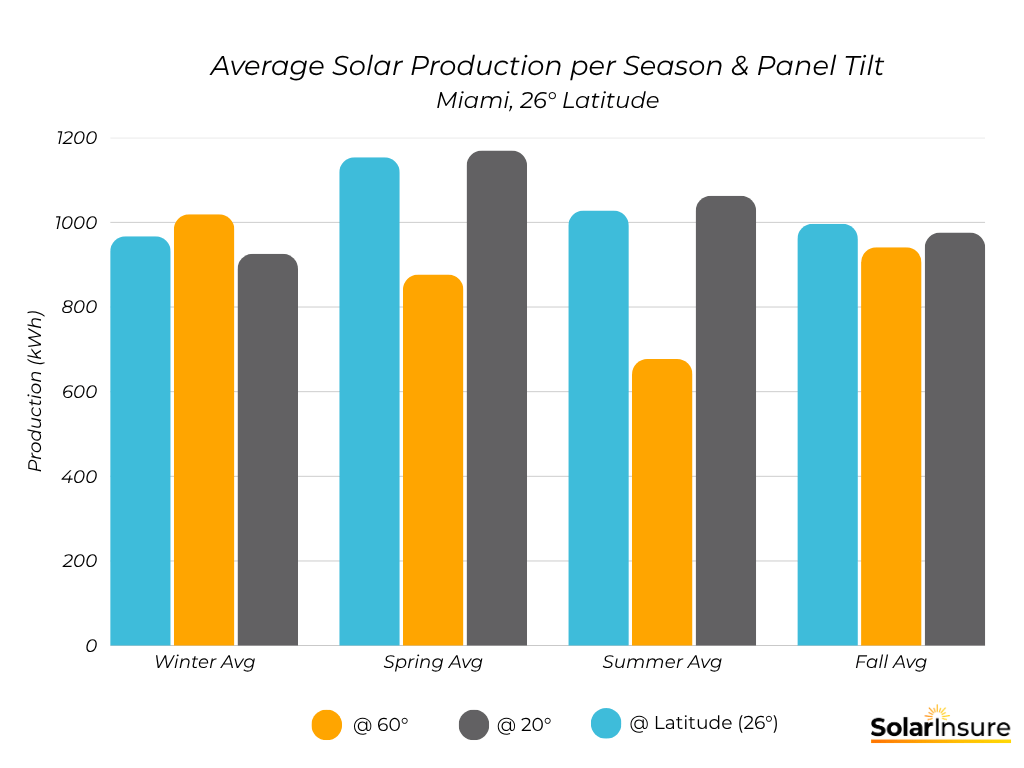One of the most common questions people who have worked in solar get from homeowners is “What happens to solar performance in the wintertime?”
I worked in the Midwest, where winters are cold, dark, and snowy. Even in warmer climates, solar sales reps would have to explain that with fewer hours of sunshine in the winter, solar performance drops, in some cases, more than you would expect.
While on a basic level, everyone knows there isn’t as much sunlight in the winter, it often surprises homeowners to hear this. Almost all solar quotes will display production on an annual basis, so it’s easy for homeowners to think that panels produce the same amount of energy every month.
To be fair to solar quotes, the total amount of energy produced over the year is the most accurate representation, as homeowners aim to offset as much, if not all, of their annual energy consumption needs.
But the confusion among many homeowners begs the question: What is the difference between production at different times of the year?
As you might have guessed, the answer is not as simple as you may think.
Table of Contents
The Reason for the Seasons
In a previous article, we discussed how the changing angle of the sun relative to your location on Earth creates the seasons. During the summer months, the sun is at a higher angle in the sky and above the horizon for longer periods, while during the winter months, it is at a lower angle in the sky and above the horizon for shorter periods.
In that article, we examined sample cities, including Chicago, Los Angeles, and Miami, to determine the effect that different panel angles have on solar production. To summarize the key findings of that study:
- Panels angled at 20° produced the most energy in the summer months across all three locations
- Panels angled at 60° produced the most energy during the winter months at all three locations
- Panels angled to match the latitude produced the most energy overall.
For this study, we’re going to utilize that same dataset.
The Performance Data and Definitions
For this study, we utilized the same data set as the previous article. Our locations are:
- Chicago, at roughly 42° latitude
- Los Angeles, at roughly 34° latitude
- Miami, at roughly 26° latitude.
The simulations were run in NREL’s PV Watts calculator, assuming standard panels, an 8 kW system size, 180° azimuth, standard losses, and weather data specific to each location.
To determine seasons, we divided up the year into three-month periods based on astronomical dates, i.e., the winter being the winter solstice (December 21-22) to the vernal equinox (March 20-21).
The seasons are broken down as follows:
- Winter – December, January, February
- Spring – March, April, May
- Summer – June, July, August
- Fall – September, October, November
If you live in a northern climate, you know it can and has snowed starting in October and going as late as April, and those in southern climates may not know what winter is, but for this study, we’ll go with the above. Production data for all three months is averaged to determine the season average at each angle.
The Results
Average Solar Performance per Season & Tilt – Chicago

Average Solar Performance per Season & Tilt – Los Angeles

Average Solar Performance per Season & Tilt – Miami

The data shows us that the answer to the question, “What is the seasonal effect on solar performance?” is (as with many things in solar), it depends. The location of the installation and the angle at which the panels are mounted have an enormous effect on the production differences per season.
Analysis
The higher latitudes, such as Chicago, experience a more predictable performance per season. Summer is the highest among all angles, followed by spring, fall, and then winter. Compared to summer production, the percent change for a Chicago-based installation is as follows:
| % Change in Production Compared to Summer | Winter | Spring | Fall |
| @ Latitude | -37% | -10% | -22% |
| @ 60° | -20% | -4% | -7% |
| @ 20° | -53% | -15% | -36% |
Compared to summer production, winter sees a drop in production of anywhere from 20% to 53%, spring sees a decrease of 4% to 15%, and fall sees a decrease of 7% to 36%.
As the location moves southward, though, we see some interesting differences depending on the panel angle. Because the sun’s relative angle is higher in southern latitudes during the summer months, panels angled to 60° experience a harsher drop in production during the summer. At that steep angle, the sunlight is at its least direct, producing the least amount of energy.
For Los Angeles, the percent change compared to summer production is as follows:
| % Change in Production Compared to Summer | Winter | Spring | Fall |
| @ Latitude | -24% | -7% | -9% |
| @ 60° | 10% | 4% | 20% |
| @ 20° | -37% | -11% | -21% |
At a 60° angle, the production fall-off in summer is so great that winter, spring, and fall all produce more energy than summer. The production difference ranges from 4%-20% depending on the season.
At a latitude of 20°, winter experiences a 24%-37% drop, spring a 7%-11% drop, and fall a 9%-21% drop.
The same principle as above applies to Miami as well, at an even more exaggerated level. For Miami, the percent change in production compared to summer is as follows:
| % Change in Production Compared to Summer | Winter | Spring | Fall |
| @ Latitude | -6% | 12% | -3% |
| @ 60° | 51% | 30% | 39% |
| @ 20° | -13% | 10% | -8% |
The 60° angled panels produce anywhere from 30%-51% more energy in the winter, spring, and fall compared to the summer. Spring also sees an increase in production at all angles compared to summer. So in Miami, homeowners can expect their panels to produce the most power during the spring, regardless of angle.
For latitude and 20°, compared to summer, winter experiences a 6%-13% drop, and fall experiences a 3%-8% drop.
The Impact on Solar Homeowners
The key findings from the previous study still hold up, that matching the panel angle as close as possible to the location latitude will produce the most energy overall. Knowing the energy production changes by season can help homeowners to better understand how their solar energy system works.
If a home has consumption patterns, like using more production during certain seasons, knowing the production impact your installation has can help to manage expectations and allow homeowners to plan better. This information can also be valuable to solar installers, enabling them to better manage customer expectations and explain variations on net metering credits or utility bills.
If you suspect there is an issue with your solar energy system and you don’t have an installer or reliable maintenance provider, check out SolarDetect by Solar Insure. SolarDetect offers a full system health check to identify issues, provides custom action plans, dispatches services, and so much more. Learn more at https://detect.solarinsure.com/



